The Intel Broadwell Desktop Review: Core i7-5775C and Core i5-5675C Tested (Part 1)
by Ian Cutress on June 2, 2015 7:45 AM ESTGaming Benchmarks: Low End
Alien: Isolation
If first person survival mixed with horror is your sort of thing, then Alien: Isolation, based off of the Alien franchise, should be an interesting title. Developed by The Creative Assembly and released in October 2014, Alien: Isolation has won numerous awards from Game Of The Year to several top 10s/25s and Best Horror titles, ratcheting up over a million sales by February 2015. Alien: Isolation uses a custom built engine which includes dynamic sound effects and should be fully multi-core enabled.
For low end graphics, we test at 720p with Ultra settings, whereas for mid and high range graphics we bump this up to 1080p, taking the average frame rate as our marker with a scripted version of the built-in benchmark.
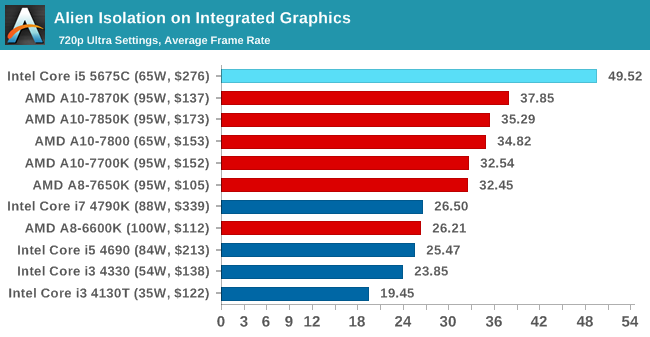

Starting off with Alien Isolation really sets the pace for the rest of these iGPU benchmarks. So far in the socketed desktop AMD has been going up against Intel's Haswell Gen7.5 GT2 iGPU configurations, and trouncing them easily. However with the bump up in EUs that comes from going with GT3e, and a further bump from the Crystal Well eDRAM, Intel now has enough iGPU performance to push well past the AMD solutions and take the lead. Against the fastest socketed APU, the Kaveri Refresh A10-7870K, the Core i5-5675C has a 31% lead, and while we don't have the i7 available, it's reasonable to expect that it would be a bit faster, if only due to the 50MHz (5%) faster iGPU frrequency.
Otherwise looking at low-end dGPU performance, there's little to say. We're badly GPU-limited long before we get to the new Broadwell SKUs.
Total War: Attila
The Total War franchise moves on to Attila, another The Creative Assembly development, and is a stand-alone strategy title set in 395AD where the main story line lets the gamer take control of the leader of the Huns in order to conquer parts of the world. Graphically the game can render hundreds/thousands of units on screen at once, all with their individual actions and can put some of the big cards to task.
For low end graphics, we test at 720p with performance settings, recording the average frame rate. With mid and high range graphics, we test at 1080p with the quality setting. In both circumstances, unlimited video memory is enabled and the in-game scripted benchmark is used.
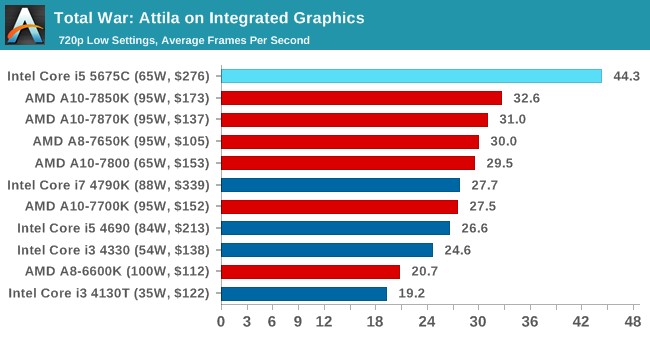
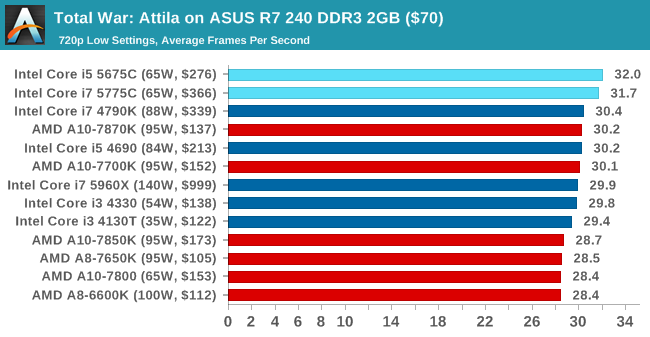
The i5-5675C's lead continues to be substantial here; Intel's i5 is ahead of the best AMD APU by 36%. Meanwhile we surprisingly see the Broadwell SKUs also edge out everything else to take the top spot in the low-end dGPU benchmark.
Grand Theft Auto V
The highly anticipated iteration of the Grand Theft Auto franchise finally hit the shelves on April 14th 2015, with both AMD and NVIDIA in tow to help optimize the title. GTA doesn’t provide graphical presets, but opens up the options to users and extends the boundaries by pushing even the hardest systems to the limit using Rockstar’s Advanced Game Engine. Whether the user is flying high in the mountains with long draw distances or dealing with assorted trash in the city, when cranked up to maximum it creates stunning visuals but hard work for both the CPU and the GPU.
For our test we have scripted a version of the in-game benchmark, relying only on the final part which combines a flight scene along with an in-city drive-by followed by a tanker explosion. For low end systems we test at 720p on the lowest settings, whereas mid and high end graphics play at 1080p with very high settings across the board. We record both the average frame rate and the percentage of frames under 60 FPS (16.6ms).
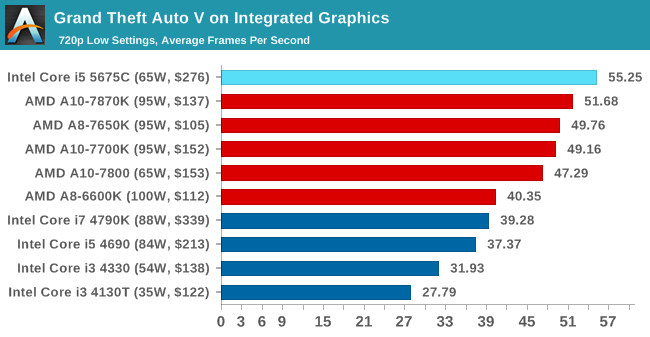
![Grand Theft Auto V on Integrated Graphics [Under 60 FPS]](https://images.anandtech.com/graphs/graph9320/74941.png)
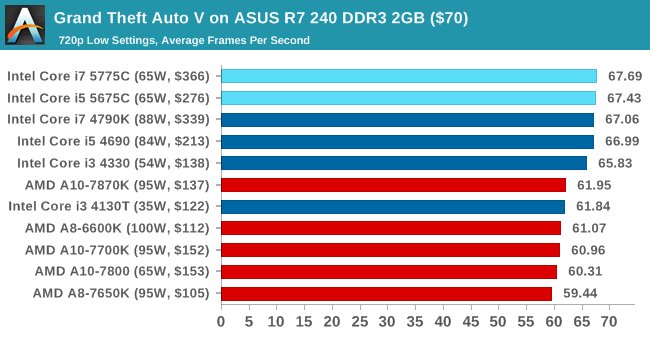
![Grand Theft Auto V on ASUS R7 240 DDR3 2GB ($70) [Under 60 FPS]](https://images.anandtech.com/graphs/graph9320/74949.png)
Though the i5-5675C and its Iris Pro 6200 GPU are still in the lead with Grand Theft Auto V, Intel's advantage has been curtailed significantly. to just 7%. Intel still has the lead, and it's large enough to matter, but it's still not very big compared to an AMD chip half its price.
GRID: Autosport
No graphics tests are complete without some input from Codemasters and the EGO engine, which means for this round of testing we point towards GRID: Autosport, the next iteration in the GRID and racing genre. As with our previous racing testing, each update to the engine aims to add in effects, reflections, detail and realism, with Codemasters making ‘authenticity’ a main focal point for this version.
GRID’s benchmark mode is very flexible, and as a result we created a test race using a shortened version of the Red Bull Ring with twelve cars doing two laps. The car is focus starts last and is quite fast, but usually finishes second or third. For low end graphics we test at 1080p medium settings, whereas mid and high end graphics get the full 1080p maximum. Both the average and minimum frame rates are recorded.
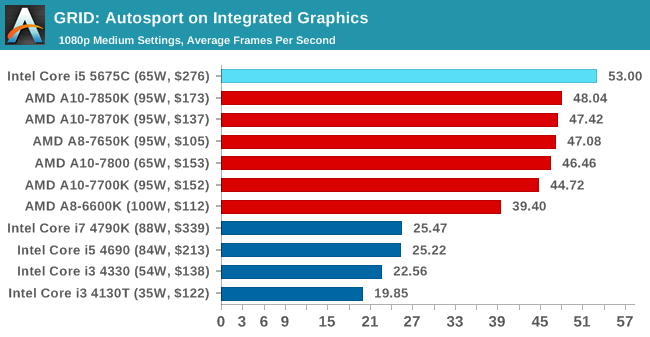
![GRID: Autosport on Integrated Graphics [Minimum FPS]](https://images.anandtech.com/graphs/graph9320/74943.png)
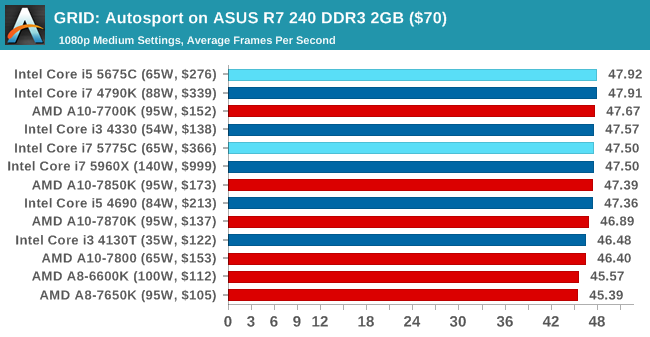
![GRID: Autosport on ASUS R7 240 DDR3 2GB ($70) [Minimum FPS]](https://images.anandtech.com/graphs/graph9320/74951.png)
Intel's lead with GRID: Autosport is again not especially large, but it is a solid 10% advantage here.
Middle-Earth: Shadows of Mordor
The final title in our testing is another battle of system performance with the open world action-adventure title, Shadows of Mordor. Produced by Monolith using the LithTech Jupiter EX engine and numerous detail add-ons, SoM goes for detail and complexity to a large extent, despite having to be cut down from the original plans. The main story itself was written by the same writer as Red Dead Redemption, and it received Zero Punctuation’s Game of The Year in 2014.
For testing purposes, SoM gives a dynamic screen resolution setting, allowing us to render at high resolutions that are then scaled down to the monitor. As a result, we get several tests using the in-game benchmark. For low end graphics we examine at 720p with low settings, whereas mid and high end graphics get 1080p Ultra. The top graphics test is also redone at 3840x2160, also with Ultra settings, and we also test two cards at 4K where possible.
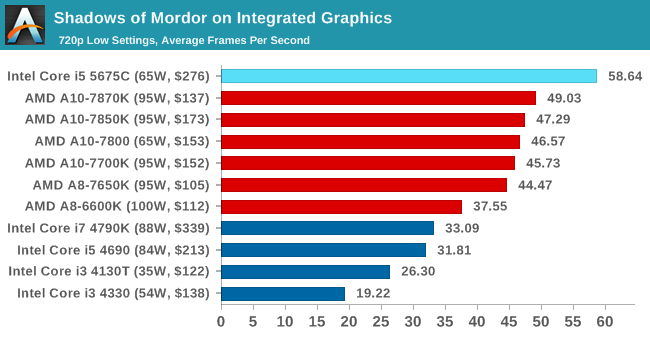
![Shadows of Mordor on Integrated Graphics [Minimum FPS]](https://images.anandtech.com/graphs/graph9320/74945.png)
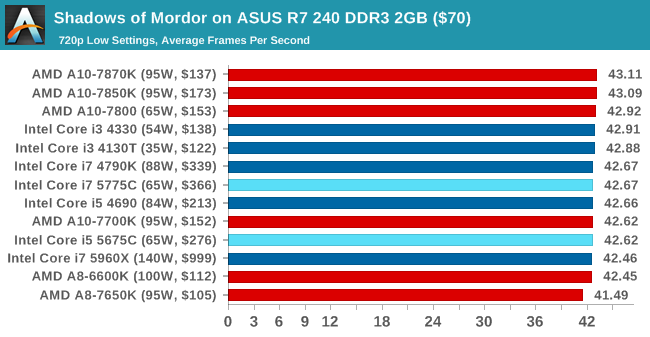
![Shadows of Mordor on ASUS R7 240 DDR3 2GB ($70) [Minimum FPS]](https://images.anandtech.com/graphs/graph9320/74953.png)
Finally, with Shadows of Mordor the Intel/AMD gap widens once more. The i5-5675C is 20% faster than the best AMD APU, and falls just short of cracking a 60fps average.
Conclusions on Low-End Graphics
The results of our look at iGPU gaming are clear: Broadwell-DT takes the iGPU performance crown from AMD's APUs. The advantage will vary with the game, but with an average lead of 20% and never once falling behind AMD's APUs, the i5-5675C and its Iris Pro 6200 are clearly the faster option. Ultimately nothing here should be a surprise to AMD - what's changed is not the existence of Iris Pro, but rather the fact that it now comes in a socketed form factor - but for system builders this represents a new option for building a system driven solely by its iGPU.
That said, with a price tag around 2x the cost of AMD's best APU, this is a very expensive way to get another 20%. Combining another CPU with a discrete GPU is almost certainly going to be a better option as far as cost effectiveness goes. But as far as integrated GPUs go Intel does hold the top position.















196 Comments
View All Comments
Peichen - Tuesday, June 2, 2015 - link
Intel is ridiculous in what way? You know Skylake is out in 2 months and that's why you are waiting for it. If you think Skylake isn't going to deliver why bother to wait? Intel haven't failed to deliver since Pentium M unlike AMD which is just one dropped ball after another. Sit tight and is gamers will have Skylake in no time. Today's release is for system builders that need a stopgap product, not us.Khenglish - Tuesday, June 2, 2015 - link
Why is the L3 cache only 6MB? Is 2MB disabled, or did intel cut the L3 size to reduce latencies since there is now an L4?Ryan Smith - Wednesday, June 3, 2015 - link
i5 processors typically have some of their L3 cache disabled.HollyDOL - Tuesday, June 2, 2015 - link
First time in years I am not sure what to think about this new cpu... Is it good? Is it delivering? On some things it quite rocks, on other seems like unfinished product/partial release... guess following months will tell...Valantar - Tuesday, June 2, 2015 - link
Just wondering: As previous Iris Pro vs. other integrated graphics reviews have shown Iris Pro to perform substantially worse at higher resolutions, are more tests above 720p coming in part 2? Or are you just going for whatever setting gets reasonably playable frame rates?sonicmerlin - Tuesday, June 2, 2015 - link
Why the frack didn't you test a midrange card at 720p so we can compare it to Iris Pro? They can't even do 30 fps at 1080p on most of the games you tested. What were you thinking?!bobhays - Tuesday, June 2, 2015 - link
On the low end gaming benchmarks for GRID, when benchmarking the r7 240 the minimum FPS for the A10-7700k is higher than the average FPS which doesn't make sense.bobhays - Tuesday, June 2, 2015 - link
Also wish they had tested dual graphics with a r7 240. The A10 ~ 130 + r7 240 ~ 70 = 200. That way we could compare a 200 dollar APU + GPU vs Intels new 200 dollar cpu'sOrphanageExplosion - Wednesday, June 3, 2015 - link
I've tried it with an A8 7650K and I can tell you that the frame-pacing is horrible, and the variance in frame-rate is stupendous. Crysis 3, 720p, low - 60fps looking in one direction, spin around on the spot and you're looking at 20-30fps looking in another direction.ryrynz - Wednesday, June 3, 2015 - link
Might wanna fix up that 128MB eDRAM comment Ian.